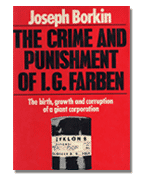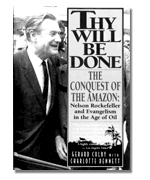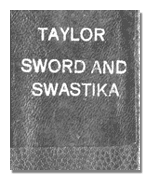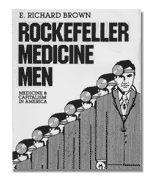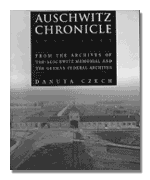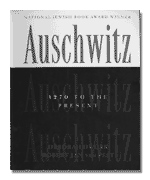- Have any questions? Contact us!
- info@dr-rath-foundation.org

The Investment ‘Business With Disease’
June 14, 2003
IG Фарбен и история «бизнеса на болезнях»
June 18, 2003IG Farben and the History of the “Business With Disease”
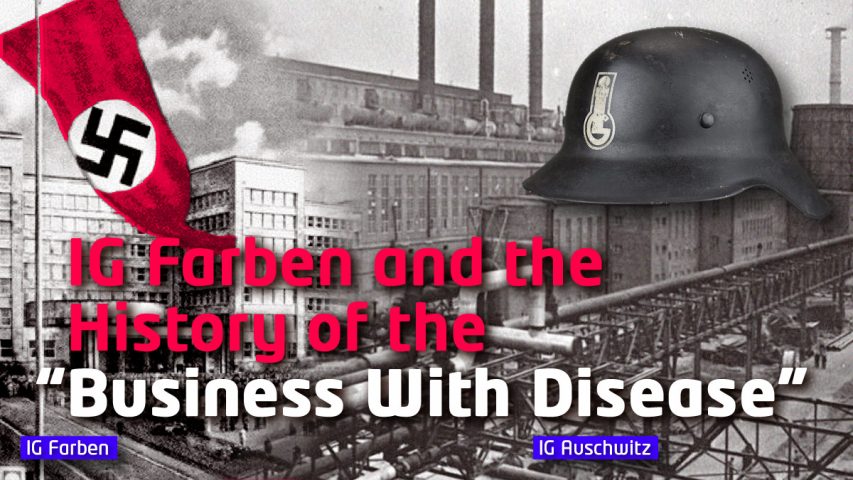
The Nuremberg War Tribunal
The Nuremberg War Criminal Tribunal convicted 24 IG Farben board members and executives on the basis of mass murder, slavery and other crimes against humanity. Amazingly however, by 1951 all of them had already been released, continuing to consult German corporations. The Nuremberg Tribunal dissolved the IG Farben into Bayer, Hoechst, and BASF.
Today each of the three daughters of the IG Farben is 20 times bigger than IG Farben was at its height in 1944, the last year of the Second World War.
More importantly, for almost three decades after the Second World War, BASF, Bayer and Hoechst (now Aventis) each filled its highest position, chairman of the board, with former members of the Nazi, NSDAP:
- Carl Wurster, chairman of the board of BASF until 1974 was, during the war, on the board of the company manufacturing Zyklon-B gas
- Carl Winnacker, chairman of the board of Hoechst until the late 70’s, was a member of the Sturm Abteilung (SA) and was a member of the board of IG Farben
- Curt Hansen, chairman of the board of Bayer until the late 70’s, was co-organizer of the conquest of Europe in the department of “acquisition of raw materials.” Under this leadership the IG Farben daughters, BASF, Bayer, and Hoechst, continued to support politicians representing their interests.
During the 50’s and 60’s they invested in the political career of a young representative from a suburb of the BASF town of Ludwigshafen, his name: Helmut Kohl.
From 1957 to 1967 the young Helmut Kohl was a paid lobbyist of the “Verband Chemischer Industrie,” the central lobby organization of the German pharmaceutical and chemical cartel. Thus, the German chemical and pharmaceutical industry advanced one of its own as a political representative, leaving the German people with only the choice of final approval.
Nuremberg War Tribunal 1946/47: 24 managers of Hoechst, Bayer and BASF were indicted for mass murder, slavery and other crimes against humanity.
The result is well known: Helmut Kohl was chancellor of Germany for 16 years and the German pharmaceutical and chemical industry became the world’s leading exporter of chemical products, with subsidiaries in over 150 countries, more than IG Farben ever had. Several billion people will now die prematurely, if the pharmaceutical industry gets its way. Germany is the only country in the entire world in which a former paid lobbyist for the chemical and pharmaceutical cartel was head of the government. To sum up, the support of German politics for the global expansion plans of the German pharmaceutical and chemical companies has a 100-year-old tradition.
From knowing this, we understand the support from Bonn for the unethical plans of the Codex Commission. (Remark made by the Dr. Rath Health Foundation)
The U.S. lead prosecutor in the Nuremberg War Criminal Tribunal against the IG Farben anticipated this development when he said, “These IG Farben criminals, not the lunatic Nazi fanatics, are the main war criminals. If the guilt of these criminals is not brought to light and if they are not punished, they will represent a much greater threat to the future peace of the world than Hitler if he were still alive.”
The Disgraced Managers of IG Farben
 Fritz ter Meer (1884-1967)
Fritz ter Meer (1884-1967)
- Member of the IG FARBEN executive committee 1926-1945, member of the working committee and the technical committee, director of section II
- 1943 plenipotentiary for Italy of the Reich Minister for armaments and war production, military economist chief industrialist responsible for Auschwitz .
- 1948 found guilty of “plundering” and “enslavement” and condemned to seven years detention. Released 1952.
- 1955 board member of Bayer
- 1956-1964 chairman of the board of Bayer chairman of the board of Th. Goldschmidt AG, deputy chairman of the board of Commerzbank, Bank-Association AG, board member of the Waggonfabrik Uerdingen, the Duesseldorfer waggonfabrik AG, the bank association West Germany AG and the United Industrial enterprises AG (VIAG)
Otto Ambros (1901-1990):
- Member of the IG FARBEN executive committee 1938-1945, member of the chemical committee and chairman of commission K (agents), special advisors of Krauchs F+E department for the four-year plan, director of the special committee C (chemical agents), the main committee for powders and explosives in the office for arms, military industrial leader
- Responsible for choice of location, planning, building and running of IG Auschwitz as operations manager. Managing director of the Buna-Works and synthetic fuel production
- 1945 knight’s cross and Distinguished Service Cross
- 1948 found guilty of “enslavement” condemned to eight years detention.
- Released 1952.
- Starting in 1954 chairman, deputy chairmen and member of the boards of: Chemie Grünenthal, Pintsch Bamag AG, Knoll AG, Feldmühle Papier- und Zellstoffwerke, Telefunken GmbH, Grünzweig & Hartmann, Internationale Galalithgesellschaft, Berliner Handelsgesellschaft, Süddeutsche Kalkstickstoffwerke, Vereinigte Industrieunternehmungen (VIAG) with its subsidiaries Scholven-Chemie and Phenol-Chemie as an advisor to F. K. Flick und of the US Industrialist J.P. Grace is entangled in the early eighties in the “Flick scandal”
Hermann Schmitz (1881-1960)
- Member of the IG FARBEN executive committee 1926-1935, chairman of the board 1935-1945 and “head of finances” to the IG
- Head of military economics, member of the Nazi party (NSDAP)
- 1941 Distinguished Service Cross 1st. Class
- 1948 found guilty of “plundering” condemned to four years in prison. Released 1950.
- 1952 board member of the German bank Berlin West
- 1956 honorary chairman of the board of Rheinish steel plants.
Fritz Gajewski (1888-1962)
- Member of the IG FARBEN executive committee 1931-1945, head of section III (point of contact to Dynamite Nobel)
- At Nuremberg , found “not guiltily” for all charges
- 1949 managing director, 1952 chairman of the board of Dynamite Nobel AG
- 1953 Distinguished Service Cross of the Federal Republic of Germany
- 1957 retirement, honorary chairman of the board of Dynamite Nobel AG, chairman of the board of Genschow & Co. and the Chemie-Verwaltungs AG, board member of Huels AG and the Gelsenkirchener mines
Heinrich Buetefisch (1894-1969)
- Member of the IG FARBEN executive committee 1934-1945, deputy director of section I, director of gasoline synthesis for IG Auschwitz
- 1932 (together with Gattineau) had the conversation with Hitler, that defined the petrol pact, 1936 co-worker of Krauch on the four year plan as a production representative for oil in the Arms Ministry
- SS Obersturmbannführer, military industrial leader, awarded the “friend of the Reich leader SS” cross.
- 1948 found guilty of “enslavement” condemned to six years detention.
- Released 1951.
- 1952 supervisory board member of Ruhr-Chemie and Kohle-Öl-Chemie among others.
- 1964 Distinguished Service Cross of the Federal Republic of Germany. The award was taken back after 16 days due to violent protests
Friedrich Jaehne (1879-1965)
- Member of the IG FARBEN executive committee 1934-1945, chief engineer of the IG, deputy director of the BG central Rhine/Maingau
- 1943 head of military economics, Distinguished Service Cross 1st. Class 1948 found guilty of “plundering” condemned to 18 months detention
- 1955 supervisory board member of the “new” Farbwerke Hoechst. In the same year elevated to supervisory board chairman elect – Karl Winnacker said “in the meantime the liquidation conclusion law had been issued and freed us from all discriminating regulations. So we could add Friedrich Jaehne, chief engineer of the old IG, to the supervisory board. He presided over this committee until 1963. In 1945 none of us would have thought that the two of us would be able to co-operate at the head of our company “.
- Supervisory board chairman of the Alfreds Messer GmbH (later Messer Griesheim), supervisory board member with Linde
- 1959 Dr. Ing. E.h. of TH Munich, 1962 Bavarian service medal, honorary senator of TH Munich, Distinguished Service Cross of the Federal Republic of Germany
Carl Krauch (1887-1968)
- Member of the IG FARBEN executive committee 1926-1940, chairman of the board 1940-1945, director of the coordination center W, director of the Reich office for economics, plenipotentiary for special questions on chemical production, military industrial leader.
- 1943 Knight’s Cross for Distinguished War services.
- 1948 found guilty of “enslavement” and condemned to six years in prison. Released 1950.
- 1955 board member of Huels GmbH.
- In 1956 in the Frankfurt Auschwitz court case is quoted as saying: “they were usually anti-social elements, so called political prisoners” (describing the prisoners of Auschwitz-Monowitz)
Carl Wurster (1900-1974)
- Member of the IG FARBEN executive committee 1938-1945, director of BG upper Rhine, board member of DEGESCH
- Head of military economics and member of the military economic advisory council of the Reich chamber of economics
- 1945 Knight’s Cross for Distinguished War Services
- At Nuremberg , found “not guiltily” of all charges
- 1952 chairman of the board of the “new” BASF, chairman of the board for Duisburger Kupferhuette and Robert Bosch AG, board member of Augusts Viktoria, the Buna-Werke Huels GmbH, Süddeutschen Bank, Deutschen Bank, Vereinigten Glanzstoff, BBC, Allianz, Degussa, 1965 retirement as chairman of the board of BASF
- 1952 honorary professor of the University of Heidelberg , Dr. rer. RK h.c. the University of Tübingen , 1953 Dr. Ing. E.h. of the TH Munich, 1955 Distinguished Service Cross of the Federal Republic of Germany, Bayer service medal, 1960 Dr. rer. pole h.c. the University of Mannheim, honorary senator of the Universities of Mainz, Karlsruhe and Tübingen, honorary citizen of the University of Stuttgart, honoury citizen of the city of Ludwigshafen, 1967 Schiller prize of the city of Mannheim, president of the federation of the chemical industry, vice-president of the Max-Planck company, the company of German chemists.
From “Arbeit macht frei” to “Codex Alimentarius”
Just fifteen years after they were convicted in the Nuremberg War Crimes Tribunal, Bayer, BASF and Hoechst were again the architects of the next major human rights offences. In 1962, they established the Codex Alimentarius Commission. (Remark made by the Dr. Rath Health Foundation)
This dark period of German history is inextricably bound to one man, Fritz ter Meer:
- He was a member of the Managing Board of IG Farben from its inception to its dissolution. As the Wartime Manager, he was responsible for IG Auschwitz.
- In the Nuremberg Tribunal, ter Meer stated: “Forced labor did not inflict any remarkable injury, pain, or suffering on the detainees, particularly since the alternative for these workers would have been death.”
- In 1948, ter Meer was sentenced by the Nuremberg Tribunal to seven years in prison for plundering and slavery.
- In 1952, his sentence was commuted, due to the influence of powerful friends.
- From 1956-1964, he was reinstated as a member of the Managing Board of Bayer AG.
- In 1962, ter Meer was one of the architects of the “Codex Alimentarius – Commission” and one of the main designers of the schemes that would profit from human suffering. (Remark made by the Dr. Rath Health Foundation)
The deceptive title “Codex Alimentarius” is no accident. It was devised by the same companies and indeed the same individuals, who gave the Auschwitz concentration camp inmates the deceptive slogan “Arbeit mach frei” (“Work makes you free”). (Remark made by the Dr. Rath Health Foundation)
As long as the Nazi infection continues to work its influence and threaten the lives of untold millions, no German has the right to proclaim that the Nazi era is finished.
Literature
The Crime And Punishment of I.G. Farben by Joseph Borkin
From 1938 to 1946, Joseph Borkin was the chief of the Patent and Cartel section of the Antitrust Division of the Department of Justice in Washington, and was responsible for the wartime investigation and prosecution of the cartels dominated by I. G. Farben.
During the war, he published Germany ‘s Master Plan which led the Associated Press to say: “Joseph Borkin probably knows more about I. G. than anyone outside of it”.
Since 1946, Mr Borkin has practised Law in Washington and he has written numerous books and articles. He is chairman of the Federal Bar Association’s Committee on Standards and Judicial Behaviour, a lecturer at the Catholic University Law School , and Director of the Drew Pearson Foundation.
Thy Will Be Done by Gerard Colby and Charlotte Dennett
The Conquest of The Amazon:
Nelson Rockefeller And Evangelism In The Age of Oil
In this triumph of investigative journalism, Colby and Dennett show how Nelson Rockefeller and the largest American missionary organization worked with the U.S. and foreign governments to secure resources and “pacify” indigenous peoples in the name of democracy, corporate profit and religion, resulting in massacres and genocide.
“This is a rich and fascinating book on a significant and heartbreaking subject, the work of American religion, business, politics, and wars in the eradication and mass murder of the native peoples of the Amazon rain forest. Based on eighteen years of research in numerous archives, nearly two hundred interviews, and a bibliography twenty pages long, it is probably the definitive study for the region it covers. I know of no other book like it. Clean and moving in its attention to human details, of perpetrators, unwitting collaborators, and victims, it is a powerful argument and story that anyone concerned with might, right, and the innocent should read.” — John Womack, Jr., Professor of History, Harvard University.
Sword and Swastika by Telford Taylor
As chief of counsel for the prosecution of war criminals at Nuremberg , Brigadier General Telford Taylor had a major part in unraveling the tangled knot of guilt for the launching of the war, and for the concomitant atrocities of the Nazi era.
In his book, Mr. Taylor takes advantage of his profound knowledge of the Third Reich and of the roles of the German officer class, the industry and the Nazis.
Rockefeller Medicine Men – Medicine & Capitalism in America by E. Richard Brown
When Rockefeller Medicine Men was first published in 1979, it proved to be a controversial work. In reviewing histories of medicine from 1962 to 1982, Ronald L. Numbers called it “the most controversial medical history of the past decade”.
Part of the controversy generated by the book comes from its social-historical approach to medicine. The growing body of social histories of health-care challenges the “great physician” perspective that for so long has dominated the history of medicine.
In his book, E. Richard Brown describes the political economy of health care, integrating material from a variety of disciplines – economics, sociology, political science, epidemiology, history and social policy.
Auschwitz Chronicle 1939 – 1945 by Danuta Czech
Auschwitz represents the apex of evil; as such, if we can never understand why it existed, we can at least know how. Most documents concerning Auschwitz and its annexes, Birkenau and Monowitz, were destroyed by the Nazis as the Allies advanced at the close of the war, yet much survived to be collected into the archives of the Official Auschwitz Museum, including: more than 3,500 eyewitness accounts by former prisoners; original camp documents that detail transport and admissions lists; written orders from the commandant; orders for laboratory experiments; hundreds of original secret messages – pleas for food and help in escape attempts – smuggled out by prisoners; financial records; building and maintenance files; and information brought out at post war trials.
Auschwitz Chronicle, a collection of these documents, is a monumental reference that records – day by day, month by month – the events and developments of the concentration camp for its planning in the winter of 1939-40 to its liberation in January 1945: the construction, operation, and eventual destruction of gas chambers and crematoriums; the transports and selections; the infamous medical “experiments”; the visits and inspections by SS leaders, physicians, and the Red Cross; the secret resistance activities; and the all-too-infrequent revolts and escapes.
Danuta Czech is the former head of the research department of the Official Auschwitz Museum where, in 1955, she began the work that culminates in the Auschwitz Chronicle. Born in Poland in 1922, she was an active member of resistance in the Tarnow region during World War II.
Auschwitz: 1270 to the Present by Debórah Dwork and Robert Jan van Pelt
No symbol of the Holocaust is more profound than Auschwitz . Yet the sheer, crushing number of murders – over 1,200,000 of them – the overwhelming scale of the crime, and the vast, abandoned site of ruined chimneys and rusting barbed wire isolate Auschwitz from us.
How could an ordinary town become a site of such terror? Why was this particular town chosen? Who conceived, created, and constructed the camp? This unprecedented history reveals how an unremarkable Polish village was transformed into a killing field. Using architectural designs and planning documents recently discovered in Poland and Russia and over 200 illustrations, the definitive “Auschwitz: 1270 to the Present” traces the successive stages of how Auschwitz became the focus of a Germanized Poland and the epicenter of the Final Solution.



